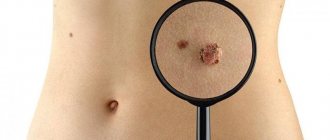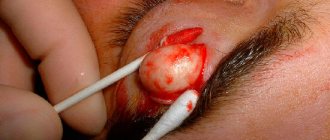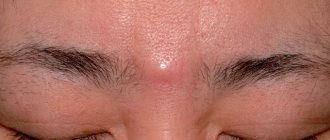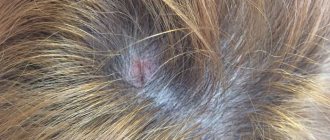Free consultation with a doctor by phone
Surgeon appointments are available daily by appointment!!!
LLC "Your Doctor"
Chat with the doctor
Addresses of medical centers in Moscow (unified reference) +7 (495) 255-45-59
Make an appointment at the clinic Discount on services Promotions
- +7 (495) 255-45-59
- Surgical centers in Moscow
- Every day from 9.00 to 20.00
- call me back
You can make an appointment with our operators by calling +7 (495) 255-45-59
Prices for services Clinic address Make an appointment Call a surgeon to your home Pediatric surgeon Ligation
Atheromas, popularly known as wen, are essentially a benign tumor in the subcutaneous tissue. They belong to the group of benign soft tissue tumors or are perceived as a squamous cell cyst.
It occurs most often in the area of large sebaceous glands: the head area (on the face or back, neck area), in the area of the interscapular space, perineum, for example, atheroma in the groin.
Useful information on the topic:
- Treatment of atheroma
- Ear atheroma
- Atheroma on the head
- Atheroma on the face
- Atheroma on the back
- Inflammation of atheroma
- Atheroma on the penis
- Atheroma of the eyelids
- Purulent atheroma
- Breast atheroma
- Laser removal of atheroma
- Removal of atheroma at home
- Atheroma on the neck
- Atheroma on the lips
- Atheroma on the leg
- Atheroma on the labia
What kind of disease
Atheroma is a benign formation, often with a genetic predisposition. An epidermal cyst looks like a thickening of the skin.
It consists of sebum and dead cells. Inside there is a white-yellow liquid with an unpleasant odor.
It is formed due to blockage of the sebaceous duct, then the discharge from it begins to accumulate under the skin and mixes with keratin. Atheroma can grow to large sizes if no measures are taken to eliminate it.
The tumor can be large or small, grow quickly or not change in size. Sometimes it can open on its own, then the liquid contained in it will flow out.
In such cases, it is important to prevent infection from entering the middle of the capsule, which can lead to infection. That's why it's so important to see a doctor.
Complications
Delaying the treatment of atheroma is fraught with suppuration of the cyst, when its capsule grows in size, swells, turns red, the skin over it becomes tense and causes pain in the patient. Independent attempts to squeeze out the contents of the formation often end with the transition of the disease to a new stage - abscessing atheroma, accompanied by swelling of nearby tissues and lymph nodes, severe pain, and general intoxication of the body. The most unfavorable outcome of the developing situation may be the entry of infection from the purulent sac into the patient’s circulatory system, which can cause sepsis.
If you are looking for where to remove a wen, contact the surgical department of the Miracle Doctor clinic. Experienced surgeons will diagnose and treat using the optimal method.
Make an appointment on the clinic’s website in the “Schedule” section or by calling the hotline.
Causes
The following factors can lead to the occurrence of atheroma:
- heredity;
- general hypertrophy;
- hormonal imbalance , which can cause hypersecretion of lipid substances in the glandular tissue of the skin;
- increased sweating;
- unhealthy diet, where fatty foods and sweets predominate;
- failure to comply with basic hygiene rules;
- metabolic disorders ;
- mechanical damage to the skin.
Treatment of atheroma without surgery
It is possible to cure atheroma without surgery, if it is not inflamed and does not fester.
The development of atheroma largely depends on hormonal disorders in the body. When hormones are imbalanced, the oiliness of the skin increases, which significantly increases the likelihood of skin cysts.
The cause of the appearance of cysts in intimate places in women is often metabolic disorders, in particular the presence of a disease such as diabetes.
Causes and signs of occurrence
The main reason is blockage of the sebaceous glands. Sebum, which is produced by the sebaceous glands, enters the skin and accumulates there. Since the sebaceous glands produce very little sebum per day, therefore, as a rule, atheroma grows very slowly. Although wen is not dangerous to health, it creates a certain discomfort and, when inflamed or suppurated, also causes pain. They may appear and disappear spontaneously. Even if the wen has disappeared, this does not mean that the problem does not exist; it may arise again. So, what provokes their appearance:
- failure to comply with personal hygiene rules;
- genetic predisposition;
- skin diseases, allergies;
- endocrine, hormonal disorders;
- metabolic disorders;
- poor nutrition;
- bad habits.
Atheromas in the groin can be detected during water procedures. Even if there is no pain, you will feel lumps on the skin. At the same time, they are mobile. Often an inflamed red nodule can be painful, especially when touched.
Due to the fact that atheroma in the groin has a high probability of inflammation and infection, since the risk of injury is quite high. This leads to unwanted inflammatory processes.
Conclusion: at the first signs of this disease, be sure to consult a doctor. The sooner you take action, the easier and faster the treatment will be.
Useful information about visiting a surgeon at the clinic:
- How to prepare for a surgeon's appointment
- What diseases does the surgeon treat?
- Calling a surgeon to your home
- Surgical care in the clinic
- Surgical care at home
- What symptoms should you contact a surgeon for?
- Treatment of surgical diseases
- Treatment of intestinal pathologies
- Treatment of skin surgical pathologies
- Treatment of bedsores and necrosis
- Treatment of parasitic diseases
- Treatment of inflammatory processes of soft tissues
- Treatment of diseases of the musculoskeletal system
- Diagnosis of surgical diseases
Symptoms
In appearance, atheroma is a small round formation. The cyst is smooth and mobile, has a dense consistency and clear boundaries.
There is no pain when pressing on the tumor, and there is no swelling or redness either.
In the center of the atheroma, the excretory duct of the sebaceous gland is often visible, which is increased in size.
If a tumor appears on the labia with similar symptoms, you should immediately contact a gynecologist.
General information about atheroma and its location
A benign tumor of the dermis is registered in 10% of patients, mainly in women over 30 years of age. Atheroma is often combined with seborrhea and acne. A neoplasm is formed on the skin with a large number of sebaceous glands: in the area of the head, mammary glands, back or face. The tumor reaches 1-5 cm, sometimes there are varieties with large sizes.
The pathological process affects different areas:
- scalp and back;
- cheeks, forehead, chin;
- earlobes or auricles;
- back, side surface of the neck;
- breast.
Less commonly, you can find atheroma on the lower extremities, genitals, in the groin area, in the area of the labia or scrotum.
Neoplasms are represented by pronounced cosmetic defects that provoke psychological discomfort in patients. Patients often turn to surgeons to remove tumors. Operations are carried out due to the risk of infectious pathogens entering the capsule and subsequent suppuration of the atheroma. The contents of the neoplasm are considered a favorable environment for the proliferation of bacteria and subsequent inflammation with the formation of cavities filled with pus.
The suppuration of tumors is caused by various mechanical injuries to the sites of their formation. In most cases, the cause of the appearance of pus in the capsules cannot be determined, which leads to the diagnosis of “purulent idiopathic atheroma.”
Diagnostics
During examination and palpation, the doctor can easily diagnose atheroma. In the center of the formation, the outlet of the sebaceous duct is often visible, and if it is not completely closed, a yellowish liquid with an unpleasant odor will slowly ooze through it.
Through the thin skin of the labia, the doctor will be able to see the yellowish contents of the neoplasm. A dense structure also indicates atheroma.
The inflammatory process can make it difficult to make an accurate diagnosis. It occurs if a woman has ignored the appearance of atheroma for a long period, and the disease progresses.
In addition, diagnostics may include additional methods so that the doctor can make sure that the neoplasm is not malignant.
Treatment methods
The most effective method of treating atheroma today is to remove it surgically. Surgery to remove the tumor is performed in almost all cases when it is diagnosed.
Self-medication is dangerous with complications!
Attention
Despite the fact that our articles are based on trusted sources and have been tested by practicing doctors, the same symptoms can be signs of different diseases, and the disease may not proceed according to the textbook.
Pros of seeing a doctor:
- Only a specialist will prescribe suitable medications.
- Recovery will be easier and faster.
- The doctor will monitor the course of the disease and help avoid complications.
find a doctor
Do not try to treat yourself - consult a specialist.
Several types of surgery are possible.
Opening and husking the contents
This is a classic surgical method, during which the doctor makes an incision and removes the atheroma capsule along with the fluid it contains, after which self-absorbing sutures are applied. The disadvantage of this method is the possibility of relapse due to incomplete removal of the cyst contents.
Removal of atheroma and surrounding tissues
The method is used for severe inflammation. This type of operation has a significant drawback: scarring.
Endoscopic method
The operation is performed by inserting an endoscope into a small puncture and sucking out the contents of the atheroma capsule. It is quite difficult to accurately determine whether all the fluid has been removed from the capsule, so the possibility of relapse remains. The advantage of the method is the absence of seams.
Laser removal
This type of atheroma removal can be used when it is small in size. The method has a minimal risk of complications and a short recovery period.
There is another method that can be used to resolve atheromas. It involves the introduction of special drugs and carries certain risks.
The danger of using this method is that there is a high probability of relapse due to the inability to determine whether the tumor has completely reabsorbed or not.
Also, drugs can have a reverse effect on atheroma, accelerating its growth. If the treatment is effective, the result will be noticeable only after two months.
Only the doctor should choose which method will be used to eliminate the problem. The decision is made individually in each case, after the doctor evaluates all the risks and chooses the least traumatic method.
Why can our articles be trusted?
We make health information clear, accessible and relevant.
- All articles are checked by practicing doctors.
- We take scientific literature and the latest research as a basis.
- We publish detailed articles that answer all questions.
Today, it is also practiced to treat cysts in the vaginal area in women without surgery, but only if they are small in size.
Treatment of atheroma
Conservative treatment of atheroma is not effective, so it is not used in clinical practice. When a patient contacts a surgeon after a preoperative examination on an outpatient basis, the sebaceous gland cyst is opened and removed.
The training plan includes:
- clinical blood and urine tests;
- testing for HIV, syphilis and hepatitis B, C;
- blood type and Rh factor;
- coagulability.
No special preparation is needed for surgery on atheroma. But patients who are taking anticoagulants are advised to stop treatment 3-4 days before the intervention. This is necessary so as not to provoke bleeding.
Hospitalization is necessary only if the atheroma is large or if it is localized in places that pose a threat to the patient’s condition.
Removal of atheroma
Surgery is performed under local anesthesia, the skin around the cyst is infiltrated with a solution of Lidocaine or Ultracaine. Removal of atheroma is carried out in several ways:
- A longitudinal incision is made on the skin above the cyst, the edges of the wound are pushed apart, and the capsule with its contents is carefully peeled out. It is removed and the wound is treated with antiseptics. the subcutaneous tissue is sutured with absorbable threads, an atraumatic suture is applied to the skin;
- Two incisions are made bordering the atheroma. The cyst is isolated from the tissue by placing the jaws of scissors under it. The scissors are carefully opened and closed, removing the cyst. After this, the wound is sutured in layers and a cosmetic suture is applied;
- After opening the skin and the atheroma cavity, its contents are carefully removed with a special spoon and the walls are scraped out. After which they are treated with an antiseptic solution. The wound is sutured.
But removing the atheroma while preserving its capsule often gives a temporary result. The remaining epithelium on the inner surface of the capsule will continue to secrete sebum, which will form a new cyst cavity.
When removing festering atheroma, they act as in other cases of purulent wounds. The cyst is opened, its contents are removed, and the capsule is excised. The cavity is treated with antiseptics and antibiotics. The wound is not tightly sutured; drainage is left. Healing occurs by secondary intention, so there is a high probability of scar formation at the site of the cyst.
In case of severe inflammation, it is recommended to take broad-spectrum antibiotics for 3-5 days to prevent infectious complications.
Laser removal of atheroma
Laser removal of atheroma has advantages over surgical treatment. The advantages of the technique are:
- targeted impact within healthy tissues;
- aseptic effect, the laser does not come into contact with the wound and cannot cause infection. At the same time, radiation kills pathogens;
- rapid recovery after treatment;
- high percentage of complete cure;
- there is no risk of developing hypertrophic scars.
Before removing atheroma on the head with a laser, you do not need to shave the hair in the affected area. Using a laser, the surgeon can cut the skin bloodlessly, while the emitter simultaneously seals the microvessels.
When aimed at the skin, the laser causes coagulation of cell proteins and their evaporation. Therefore, they act in a targeted manner without damaging healthy tissue.
No special preparation is needed for laser treatment. Surgery for atheroma is performed on an outpatient basis. After treating the skin with an antiseptic solution and administering anesthesia, the skin is carefully cut with a laser. In some cases, a scalpel is used at this stage. Holding the atheroma capsule with clamps, it is separated with a laser from the remaining tissues. The operation is completed by applying sutures to the wound and a sterile bandage.
Preventive actions
Surgery to remove atheroma on the labia is only part of the treatment. It is very important after surgery to prevent atheroma from forming again.
The following rules will help reduce the risk of relapse of the disease:
- Correct hormonal balance if disturbances occur.
- Select hygiene and cosmetic products with special care.
- Control your weight.
- Wear underwear made from natural fabrics.
- Lead a healthy lifestyle.
- Wear special clothing and a respirator if the profession involves chemicals.
- Visit a gynecologist at least once every six months.
In the prevention of atheroma on the labia, diet plays an important role. Therefore, you need to reconsider the foods that are consumed every day, and minimize the consumption of foods rich in carbohydrates and fats.
If even a small, dense bump appears on the labia, you should not put off visiting a doctor. Only a qualified specialist can determine what kind of formation it is and select the appropriate treatment method.










